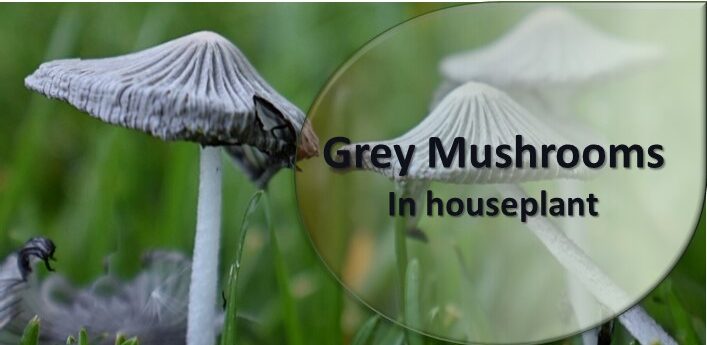If you have spotted a grey mushroom in your houseplant or garden and are searching, who are they? Grooved bonnet (Mycena polygramma), Grey Knight (Tricholoma terreum), and Grey Oyster (Pleurotus ostreatus) are three grey mushrooms that may appear in your houseplant pot. Are they harmful to my indoor plant? Are they toxic or eatable mushrooms? Join me in this article to tell you everything you should know about grey mushrooms in houseplants.
House gardeners usually report the growth of yellow, white, brown, or grey mushrooms in the houseplants, they want to know:
- Who are these mushrooms?
- How they can come in the houseplant?
- Are they harmful to the houseplants?
- How to get rid of them?
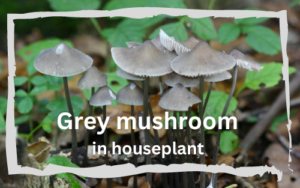
Indeed, almost all mushrooms have similar habits and spreading ways and you get rid of them with similar treatments. Hence if you are going to control your grey mushroom, I recommend reading “Mushroom growing in the houseplant | Detect them by their images + Get rid of them”.
Let’s get going to give you a brief overview of grey mushrooms in your houseplant.
What kind of grey mushroom may grow in your houseplant?
Three common types of grey mushrooms may grow in your garden or houseplant soil. In the following, we will tell you about them and you can identify them based on their images.
Some of them are toxic and others are eatable. Although we try to help you detect your grey mushrooms only professionals can confirm whether they are eatable or not, hence, avoid eating them.
A: Grooved bonnet (Mycena polygramma)

This fungus is reported from Asia, Europe, and North America including North Carolina, Massachusetts, New York, and Michigan.
Grooved bonnet loves the rich and moist soils and grows on buried wood. It decomposes organic matter and forms humus in the soil by recycling nutrients.
Its appearance:
- Its fruit bodies are small.
- It is pale grey-brown.
- It has broadly conical caps with pinkish gills.
- Its fruit body is inedible.
In the following, you can see its image and compare it with your grey mushroom.
B: Grey Knight (Tricholoma terreum)
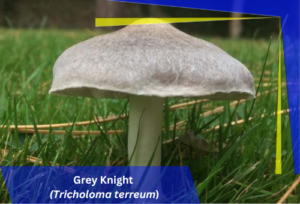
Its habitat is North America, Europe, and parts of Asia, and grows in coniferous woodlands, particularly pine and spruce.
It is also known as tiger Tricholoma, leopard knight, spotted Tricholoma, dirty trich, and tiger top.
Its appearance:
- It has a medium size fruit body (5–15 cm (2–6 in) in diameter of cap)
- Its cap before maturity is hemispherical and then becomes flattening.
- The unmatured cap has a curled inward margin that becomes uncurled as it matures.
- The cap surface is silvery-grey.
- The cap surface is patterned by darker grey, brown, or blackish scales.
- It has a white, pale grey, or pale brown stalk that is thicker at the base.
Years ago, people used it as an eatable mushroom but research shows that it can cause kidney failure. Hence avoid eating it.
In the following, you can see the Grey Knight’s image and compare it with your grey mushroom.
C: Grey Oyster (Pleurotus ostreatus)
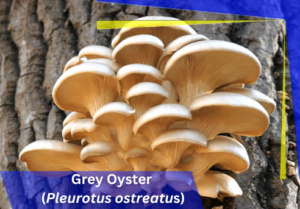
It is reported from Asia, Britain Ireland, and parts of North America. It grows on dead and dying trees, especially Beech and Oak, and rarely conifer trees, however, they can easily grow on damp straw or wood too.
Oyster mushrooms are very popular mushrooms and there are various species and subspecies of them including Grey Oysters, Yellow or Golden Oysters, Blue Oyster, etc.
Its appearance:
- They have Grey to buff caps.
- The cap edge becomes wavy with age.
- Its gills are white to ochre.
- Their stem is a short center or nub.
- They grow on trees in stacked clusters.
Oysters are grouped in valuable edible mushrooms. Hence if you find it in your houseplant you are a good lucky gardener. However, as I told you earlier, only professionals can detect eatable mushrooms, hence confer with them before eating them.
However, research confirms the presence of a small amount of Arabitol in grey oysters that can cause gastric upset.
The wonderful thing about Oyster Mushrooms is that they are carnivorous mushrooms. Don’t worry! They only food from bacteria, small insects, and nematodes inside the wood and digest them with their mycelium.
Are grey mushrooms in your houseplant harmful?
Indeed, mushrooms that grow in your houseplant are saprotrophic fungi that are not harmful to your potted plant. Mushrooms break the decaying matter into usable substances for your indoor plant and help you to have lusher houseplants.
Although, if you are concerned that, they may be eaten by your kids or pets, you should get rid of them.
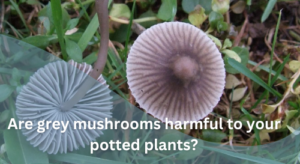
Conclusion
Now you got familiar with the three most likely grey mushrooms that may grow in your houseplant including Grooved bonnet (Mycena polygramma), Grey Knight (Tricholoma terreum), Grey Oyster (Pleurotus ostreatus). You found out they are not harmful to your houseplant, although you have to prevent being eaten by your kids or pets.
Which one of the above grey mushrooms is your new guest? Are you going to get rid of them or do you decide to leave them to do their things? Please share your ideas and experience below this page.

Elahe Rabiei
Hi, I’m Elaheh. My Academic major is plant protection, and houseplants are my expertise. As a houseplant lover, my house is full of indoor plants and it is my passion to take care of them. Hence, I’m here to share my knowledge and experience about growing healthy houseplants. I am also a plant protection advisor, so feel free to ask me any questions you may have.

